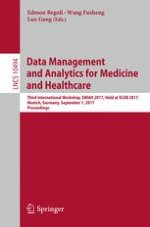This book constitutes the thoroughly refereed conference proceedings of the Third International Workshop on Data Management and Analytics for Medicine and Healthcare, DMAH 2017, in Munich, Germany, in September 2017, held in conjunction with the 43rd International Conference on Very Large Data Bases, VLDB 2017.
The 9 revised full papers presented together with 2 keynote abstracts were carefully reviewed and selected from 16 initial submissions. The papers are organized in topical sections on data privacy and trustability for electronic health records; biomedical data management and Integration; online mining of Health related data; and clinical data analytics.
